History of Krasnodar
Foundation of Yekaterinodar
According to the results of the West Caucasian archaeological expedition, in the center of Krasnodar, in the area of the park “City Garden”, a large settlement of the Maeotians was discovered, which had existed here from the 4th or 3rd century BC. Also, near Krasnodar (on the territory of the village of Yelizavetinskaya), on the banks of the Kuban River, there was an ancient town of the Bosporan Kingdom (438 BC - 370 AD) with fortifications.
In 1792, Catherine the Great, Empress of Russia, issued a Charter of Appreciation to the Black Sea Cossack Army, according to which the Kuban land, limited by the Kuban River and the Sea of Azov, was given to the Cossacks, who served and lived here. Cossacks began to move to the fertile Kuban land after the annexation of the Western Ciscaucasia to the Russian Empire as a result of the Russo-Turkish wars of the second half of the 18th century.
In 1793, the Black Sea Cossacks founded a military camp named Yekaterinodar (literally meaning “Catherine’s gift”). According to the census of 1794, 586 people lived in Yekaterinodar. The main street was named Krasnaya meaning “beautiful”. The second meaning of this word is “red”, which saved the street from renaming in the Soviet period. By 1802, the population increased to about 6,000 people.
But soon the growth of this fortified settlement practically stopped due to a decree prohibiting peasants, “newcomers and nonresident people, that is, not Cossacks”, from acquiring land and real estate in Yekaterinodar. The burdens of the Caucasian War (1817-1864) also impeded its development and restrained population growth. In 1830, near the Kuban, brick production began for the construction of different administrative buildings in Yekaterinodar. In 1856, the population of Yekaterinodar was about 8,900 people.
More historical facts…
Yekaterinodar - an important city of the Russian Empire
In 1860, according to the decree of Emperor Alexander II, the Black Sea Cossack Army was renamed the Kuban Cossacks. Yekaterinodar became the center of Kuban. In 1867, after the Caucasusian War, Yekaterinodar received the status of a town and its coat of arms. Resettlement restrictions were lifted.
In the 1870s-1880s, in connection with the construction of the Tikhoretsk - Yekaterinodar - Novorossiysk Railway, the town turned into a large commercial, industrial, and transport center of the North Caucasus region. Merchants began to settle here.
In 1888, about 43,500 people lived in Yekaterinodar. There were 8 churches and 1 cathedral, 7 hotels, 3 restaurants, 110 taverns, 250 shops, as well as 80 factories, 3 printing houses, and 1 tobacco factory in the city. In 1897, more than 65,000 people lived in Yekaterinodar. Connected by railway lines to the ports of the Black and Azov Seas, it became the railway center of Kuban.
The development of the heavy industry of Yekaterinodar began in the early 20th century. In 1911, a metal processing plant was built. In 1915, an iron foundry and other plants working on Donetsk metal and coal were commissioned. An oil refinery was established to process oil from the Maikop oil field discovered in 1909. In 1914, the population of Yekaterinodar was about 102,200 people.
During the Civil War in the territory of the former Russian Empire, Yekaterinodar de facto became the capital of the anti-Bolshevik White South of Russia.
Krasnodar in the 20th century and beyond
On December 7, 1920, Yekaterinodar was renamed to Krasnodar (literally “red gift”) with the following justification sent by local authorities to Moscow: “We consider the name Yekaterinodar to be reminiscent of slave times, completely meaningless in the republic of labor forever freed from the descendants of Catherine and their henchmen. In this regard, we ask to call the city Krasnodar.” In 1923, the population of Krasnodar was about 144,000 people.
The cultural life of Krasnodar noticeably changed in the 1930s. Gorky Drama Theater and the Operetta Theater were opened in the city. In 1933, an airport was opened in Krasnodar. On September 13, 1937, North Caucasus Krai was divided into Krasnodar Krai with a center in Krasnodar and Rostov Oblast with a center in Rostov-on-Don.
During the Second World War, Krasnodar was occupied by German troops from August 9, 1942 to February 12, 1943. Retreating from the city, German troops blew up and set fire to most of the central part of Krasnodar. After the war, the city was restored, the construction of new districts began, but the street layout of the central part of Krasnodar was preserved in the initial form of the early 19th century. In 1959, the population of Krasnodar was about 313,000 people.
In 1973, to ensure the implementation of production and land reclamation measures, a large reservoir was built in the southeastern part of Krasnodar, which also protected the city from spring floods. The population of the city exceeded half a million people.
In the 1990s, former pre-Soviet names were returned to a lot of the city’s streets, although some Soviet street names were also left on street signs. In 1993, Krasnodar celebrated its bicentennial.
After the collapse of the USSR, a decrease of urban population was observed throughout Russia. However, Krasnodar avoided this trend. After 1991, there was a constant increase in the number of residents. This growth has not stopped until now and in the coming years the population of Krasnodar is likely to exceed 1 million people.
Streets of Krasnodar
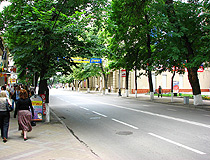
On the street in Krasnodar
Author: Shamil Khakirov
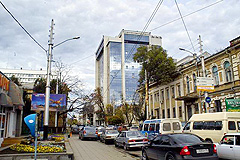
Traffic in Krasnodar
Author: Sergey Bulanov
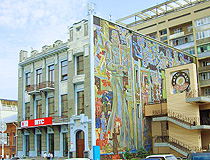
Architecture of Krasnodar
Author: Sidorenko Alexey
Krasnodar - Features
Krasnodar stands on the right bank of the Kuban River (the largest river of the North Caucasus), about 160 km from the Black Sea and 150 km from the Sea of Azov, 1,350 km south of Moscow. Unofficially, this city is called the capital of Kuban, as well as the capital of the South of Russia. The City Day of Krasnodar is celebrated on the last Saturday of September.
The city has a favorable economic and geographical position in the Southern Federal District. It is located on the most important highways connecting the center of Russia with the ports of the Black and Azov Seas, as well as the resorts of the Black Sea coast of the Caucasus. The Krasnodar reservoir, the largest artificial reservoir of the North Caucasus, is located near the city.
The most interesting fact in the geography of Krasnodar is that it is located at the 45th parallel, in the middle between the North Pole and the equator. This latitude is also called the “life line”, since it is believed that at this latitude the climatic conditions are most optimal for people to live.
The climate in Krasnodar is transitional from mild continental to subtropical with long hot summers and mild, moderately warm winters. The average temperature in July is plus 24.1 degrees Celsius, in January - plus 0.6 degrees Celsius. The hottest time of the year is the end of July - the beginning of August, when the temperature can exceed plus 40 degrees Celsius, it is better not to come to Krasnodar at this time.
Among the cities of the Southern Federal District, Krasnodar ranks third in terms of population after Rostov-on-Don and Volgograd. Krasnodar is a city of Russia, which population is growing: the influx of economic migrants from all over the Russian North Caucasus and the countries of the Caucasus, as well as the resettlement of people from the regions of the Far North of Russia and other regions.
Krasnodar is one of the largest economic centers in Russia. Food and processing industries are the most developed in the city, including the production of foodstuffs, tobacco products, vehicles, equipment, mineral fertilizers, rubber and plastic products, printing and chemical products, oil refining. The export from Krasnodar is dominated by food products.
This city is a major transport hub in the south of Russia. The territory of Krasnodar is crossed by four directions of railways, two highways of federal significance. The Krasnodar International Airport offers regular flights to a number of cities in Russia, countries of near and far abroad. Urban transport is represented by buses, trams, and trolleybuses.
A lot of tourists consider Krasnodar as a transit point on the way to sea resorts, undeservedly ignoring city attractions. And it is completely in vain, since the capital of Kuban has a considerable number of rather interesting places. There are picturesque streets and squares that are pleasant to walk along, several parks, theaters, museums, magnificent cathedrals, and monuments.
Kuban cuisine combines several cultures: Ukrainian, Russian, Uzbek, and Caucasian. There are a lot of cafes and restaurants in Krasnodar offering such traditional dishes as borsch, pancakes, dumplings, pies, etc.
Main Attractions of Krasnodar
Krasnaya Street - the central street of Krasnodar with movie theaters, restaurants, museums, shops, monuments. Musicians and artists perform on this street, souvenirs and gifts are sold here. This is a great place to start exploring Krasnodar.
Art Museum named after F. A. Kovalenko - an exhibition gallery of the early 20th century, the oldest museum of its kind in the North Caucasus. This museum has about 13 thousand exhibits: paintings, objects of arts and crafts, graphics, sculpture. Iconography of various schools is also widely shown. Krasnaya Street, 13.
Historical and Archaeological Museum named after E.D. Felitsyn. The museum has collections of paleontology, numismatics, ethnography, black-lacquered and red-lacquered ancient Greek ceramics, examples of jewelry art, exhibits on the settlement of the Kuban Cossacks of the 18th century. There is also a collection of weapons from the Stone Age to the present. This museum has one of the best collections of Polovtsian sculptures in the world. Gimnazicheskaya Street, 67.
Museum of Retro Cars. In this private museum located in the south of Krasnodar, you can see dozens of unique vintage cars. Here you can also see perfectly preserved classic Soviet cars. Voronezhskaya Street, 124.
Museum of Military Equipment “Arms of Victory” - an open-air exhibition in the Park of Culture and Rest named after the 30th anniversary of Victory, which is a collection of military vehicles of the Second World War period and later period: the T-34 tank, the ISU-152 self-propelled gun, the M-261 submarine, BTR-40, BRDM-2, and other military equipment. Beregovaya Street, 146.
The Bridge of Kisses - a small cable-stayed bridge over one of the creeks of the Kuban River built to attract visitors to a remote part of the park of the 30th anniversary of Victory. Over time, it became popular with newlyweds and couples in love, which is why it got this name.
Ocean Park Oceanarium - one of the largest oceanariums in the south of Russia. Aquariums are located on an area of 3 thousand square meters, they are inhabited by about 200 representatives of marine fauna: stingrays, piranhas, sharks, turtles, lobsters, exotic fish, mammals. Uralskaya Street, 98/11.
The Krasnodar City Garden - the oldest natural and historical monument of the city, a landscape park with picturesque alleys, flower beds, walking paths, and fountains. The pride of this park is four 600-year-old oaks, miraculously preserved to this day. Postovaya Street, 34.
Sunny Island Park - the largest park in Krasnodar and one of the best places to rest in the city. It is a small island located in the eastern part of the city with a developed infrastructure, a large number of various rides, sports grounds. There is also a private zoo (Safari Park) here in which, in addition to animals, you can see sculptures of dinosaurs.
St. Catherine’s Cathedral (1900-1914) - the main church of the Yekaterinodar and Kuban diocese. It was decided to build this cathedral in 1889 - one year after the crash of the royal train, when members of the imperial family miraculously survived. Shortly before the crash, Emperor Alexander III visited Yekaterinodar with his wife and sons. In the 1930s, when a lot of churches were destroyed, Ivan Malgerb, the architect of the cathedral, convinced local authorities to preserve the building. Kommunarov Street, 52.
St. George’s Church (1903) - a picturesque church which, unlike other churches of Krasnodar, has never been closed. This five-domed church in the Byzantine style with traditional onion domes immediately became not only a place of worship, but also one of the main attractions of Yekaterinodar. Mitrofana Sedina Street, 170.
Holy Trinity Cathedral (1910). This majestic red-brick building crowned with green and gilded domes is one of the most beautiful buildings in Krasnodar. Frunze Street, 65.
The Shukhov Water Tower - a picturesque water tower designed by engineer Vladimir Shukhov as part of the city water system in the 1930s. The design is an openwork cylinder “woven” of inclined metal rods fastened with rivets. The height of the structure is 25 meters. Today, the tower is not used for its intended purpose. It is an object of cultural heritage located at the intersection of Volodi Golovatogo and Rashpilevskaya streets.


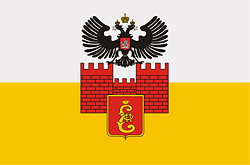
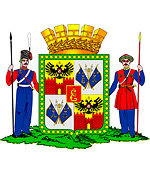
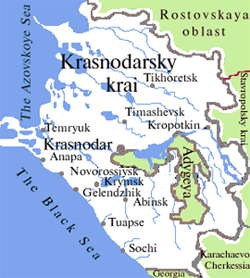



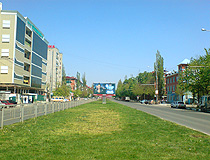
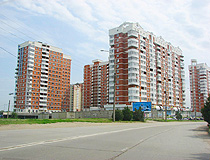
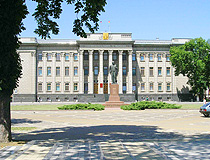
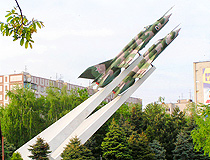
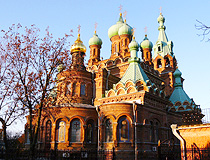
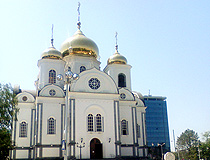
The comments of our visitors